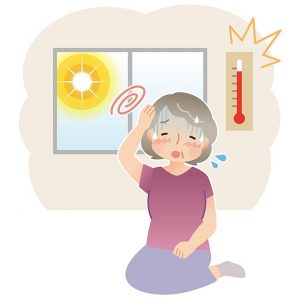Heat Stroke in Seniors
With summer upon us, it is beneficial to remind ourselves and our loved ones that the warm weather could be dangerous for some members of our families and communities. Extreme heat can be harmful to people of any age, but it is especially dangerous for senior citizens. The University of Chicago Medical Center conducted a study showing that 40% of heat-related deaths in the United States occurred in people over age 65. Heat stroke disproportionately affects senior citizens for many reasons, including lack of airflow, limited access to air-conditioning, dehydration (often caused by medications), reduced sweating (a natural result of aging and/or caused by medication), chronic illnesses, overdressing, salt-restricting diets, poor circulation, and living in warm locations. In addition, older bodies lose their ability to regulate temperatures, since they store fat differently than young people and naturally sweat less.
Most importantly, the best way to prevent heat stroke is to prevent dehydration. To do this, it is necessary for seniors to drink water and juices regularly when the temperatures outside increase. Dehydration leads to an increased inability to regulate temperature. It is recommended to consume fluids with every meal, in addition to sipping throughout the day. If an individual becomes dehydrated, an electrolyte drink can aid in rehydration. It is vital to avoid caffeinated or alcoholic beverages when it is hot out.
Going outside should be avoided when possible, especially during the hottest time of day. On extremely hot days, it is safest to stay inside between 10 am and 6 pm. Exercise should be done inside an air conditioned building instead of outside. It is also beneficial to pay attention to the heat index because the heat index is a combination of the humidity and the temperature, so it produces a more accurate idea of how hot it feels outside.
Dressing for the weather will aid in the prevention of heat stroke. This can be done by wearing light colors, light fabrics, and loose-fitting clothing. A wide-brimmed hat will keep the head, face, and shoulders out of direct sunlight. Many older people cannot feel how hot it really is, so it is necessary to remind them what the temperature is and to encourage them to wear their summer clothes.
Educating yourself and your loved ones about the signs and symptoms of heat stroke can help to ensure that it can be detected and treated as soon as possible. The first signs may include excessive sweating, tiredness, weakness, dizziness, a headache, and muscle cramps. The next stage of symptoms may include vomiting, nausea, and fainting. Within 10 to 15 minutes, these symptoms can escalate to heat stroke, which is when the internal body temperature rises faster than it is lowered. The symptoms of heat stroke may include extremely high body temperature (104 degrees Fahrenheit or above), the absence of sweating, confusion, seizure, and coma.
If you suspect someone may have heat stroke, the first thing to do is to call 911.When someone is suffering from heat stroke, they should lie down in a cool place, ideally with a fan blowing at them. The next step is to try to lower body temperature through cool baths, air-conditioning, and drinking cool fluids. With proper knowledge and understanding, it is possible to keep seniors cool and safe during the hot summer months!


